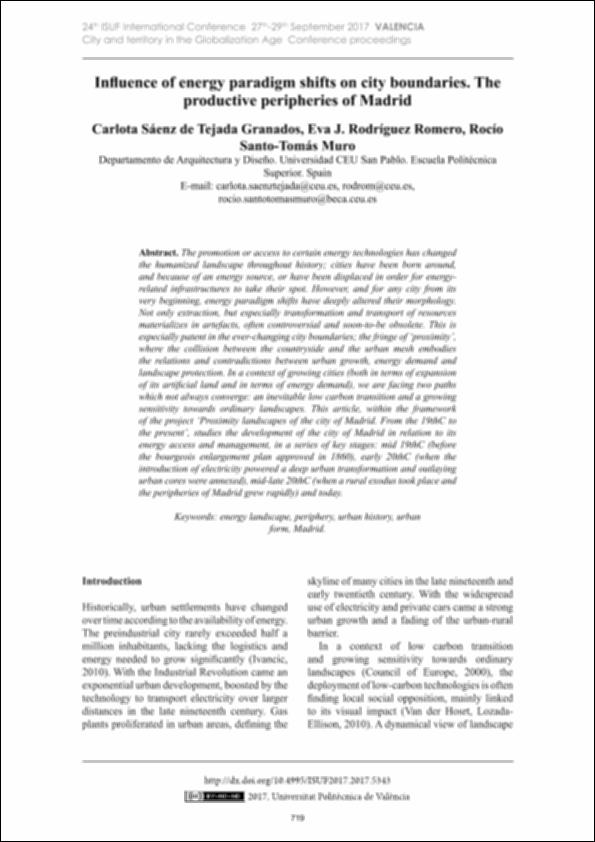Please use this identifier to cite or link to this item:
http://hdl.handle.net/10637/14369Influence of energy paradigm shifts on city boundaries. The productive peripheries of Madrid
| Title: | Influence of energy paradigm shifts on city boundaries. The productive peripheries of Madrid |
| Authors : | Sáenz de Tejada Granados, Carlota Rodríguez Romero, Eva Juana. Santo-Tomás Muro, Rocío |
| Keywords: | Energy landscape; Periphery; Urban history; Urban form; Madrid |
| Citation: | Sáenz de Tejada Granados, C;, Rodríguez Romero, E.J.; Santo-Tomás Muro, R.: ‘Influence of energy paradigm shifts on city boundaries. The productive peripheries of Madrid’ in VV.AA. ISUF 2017 XXIV International Conference: City and territory in the globalization age, Universidad Politécnica de Valencia, 2017, pp. 719-728. (ISBN: 978-84-9048-574-3, Doi: 10.4995/ISUF2017.2017.5343) |
| Abstract: | The promotion or access to certain energy technologies has changed the humanized landscape throughout history; cities have been born around, and because of an energy source, or have been displaced in order for energy-related infrastructures to take their spot. However, and for any city from its very beginning, energy paradigm shifts have deeply altered their morphology. Not only extraction, but especially transformation and transport of resources materializes in artefacts, often controversial and soon-to-be obsolete. This is especially patent in the ever-changing city boundaries; the fringe of ‘proximity’, where the collision between the countryside and the urban mesh embodies the relations and contradictions between urban growth, energy demand and landscape protection. In a context of growing cities (both in terms of expansion of its artificial land and in terms of energy demand), we are facing two paths which not always converge: an inevitable low carbon transition and a growing sensitivity towards ordinary landscapes. This article, within the framework of the project ‘Proximity landscapes of the city of Madrid. From the 19thC to the present’, studies the development of the city of Madrid in relation to its energy access and management, in a series of key stages: mid-19thC (before the bourgeois enlargement plan approved in 1860), early 20thC (when the introduction of electricity powered a deep urban transformation and outlaying urban cores were annexed), mid-late 20thC (when a rural exodus took place and the peripheries of Madrid grew rapidly) and today. |
| URI: | http://hdl.handle.net/10637/14369 |
| Rights : | http://creativecommons.org/licenses/by-nc-nd/4.0/deed.es |
| Issue Date: | 2017 |
| Center : | Universidad San Pablo-CEU |
| Appears in Collections: | Escuela de Politécnica Superior |
Items in DSpace are protected by copyright, with all rights reserved, unless otherwise indicated.


